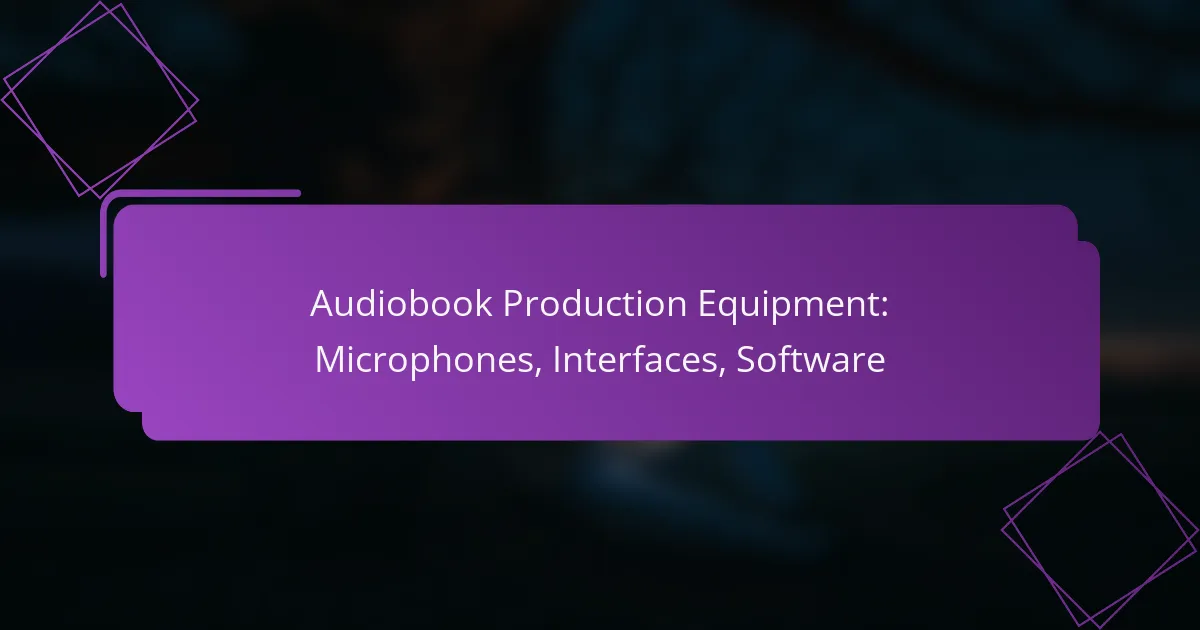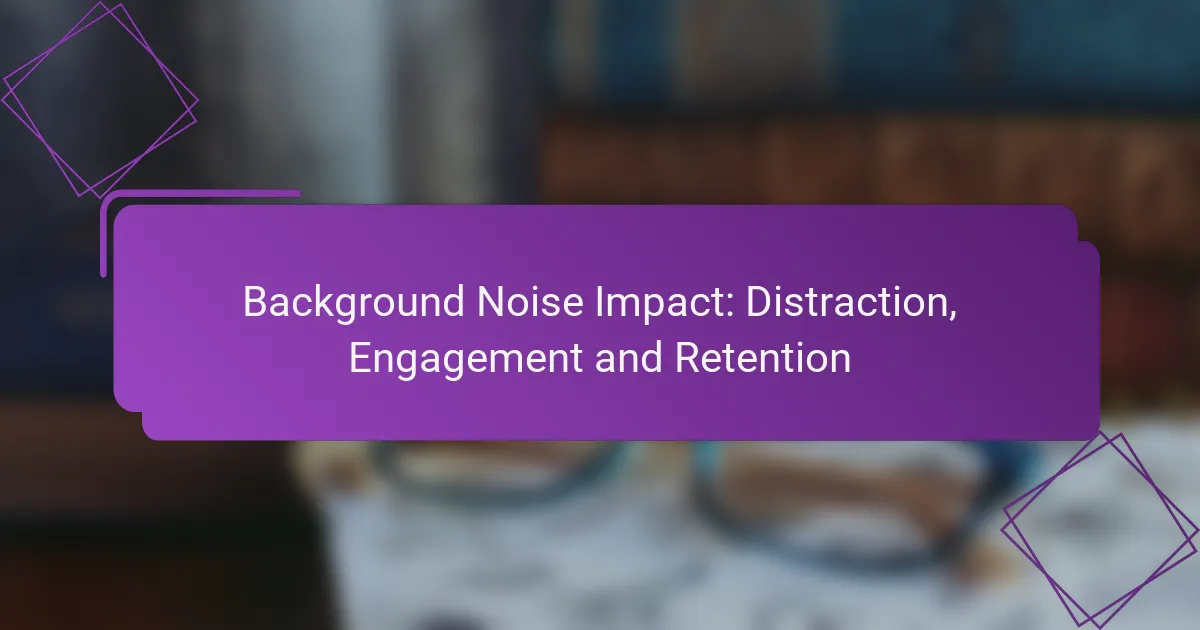Sound editing is a vital component of audiobook production, employing techniques such as noise reduction, equalization, and dynamic range compression to enhance audio clarity. Utilizing specialized tools like Adobe Audition and Pro Tools, sound editors can transform raw recordings into polished, professional-quality audiobooks. This meticulous process not only improves the listening experience but also ensures that the content is engaging and effectively communicates its message.
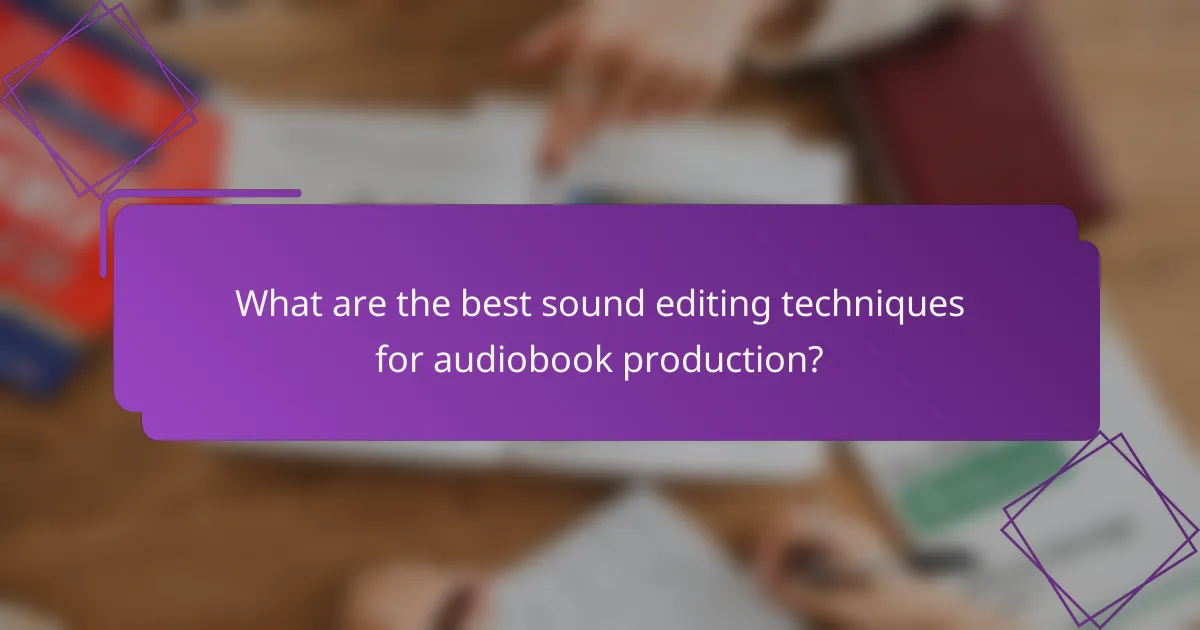
What are the best sound editing techniques for audiobook production?
The best sound editing techniques for audiobook production include noise reduction, equalization, dynamic range compression, reverb control, and volume leveling. Each technique plays a crucial role in enhancing audio clarity and ensuring a professional listening experience.
Noise reduction
Noise reduction involves eliminating unwanted background sounds that can distract listeners. This can be achieved using software tools that analyze audio frequencies and remove those that fall outside the desired range.
Common techniques include spectral editing and using noise gates. It’s important to strike a balance; excessive noise reduction can lead to unnatural audio artifacts. Aim for a reduction that maintains the integrity of the voice while minimizing distractions.
Equalization
Equalization (EQ) adjusts the balance of different frequency components in the audio. By boosting or cutting specific frequencies, you can enhance clarity and warmth in the narrator’s voice.
For audiobooks, focus on enhancing the mid-range frequencies, where the human voice resides, while reducing lower frequencies that may add muddiness. A good starting point is to cut below 80 Hz and boost around 3-5 kHz for clarity.
Dynamic range compression
Dynamic range compression reduces the volume difference between the loudest and softest parts of the audio. This technique ensures that quieter speech is audible while preventing louder sections from becoming overwhelming.
When applying compression, aim for a ratio of 2:1 to 4:1, with a threshold set just above the average speaking volume. This helps maintain a natural sound while providing consistency throughout the audiobook.
Reverb control
Reverb control manages the echo and ambiance in the recording. While a small amount of reverb can add warmth, too much can make the audio sound distant and unclear.
Use reverb sparingly, especially in audiobook production. A short reverb time of around 0.5 seconds is often sufficient to create a pleasant sound without compromising clarity. Always monitor the audio in context to ensure it remains intelligible.
Volume leveling
Volume leveling ensures consistent loudness throughout the audiobook. This technique involves adjusting the overall volume of different sections to create a uniform listening experience.
Utilize tools like normalization and manual adjustments to achieve a target loudness level, typically around -16 to -18 LUFS for audiobooks. Regularly check levels against industry standards to ensure compliance and listener satisfaction.
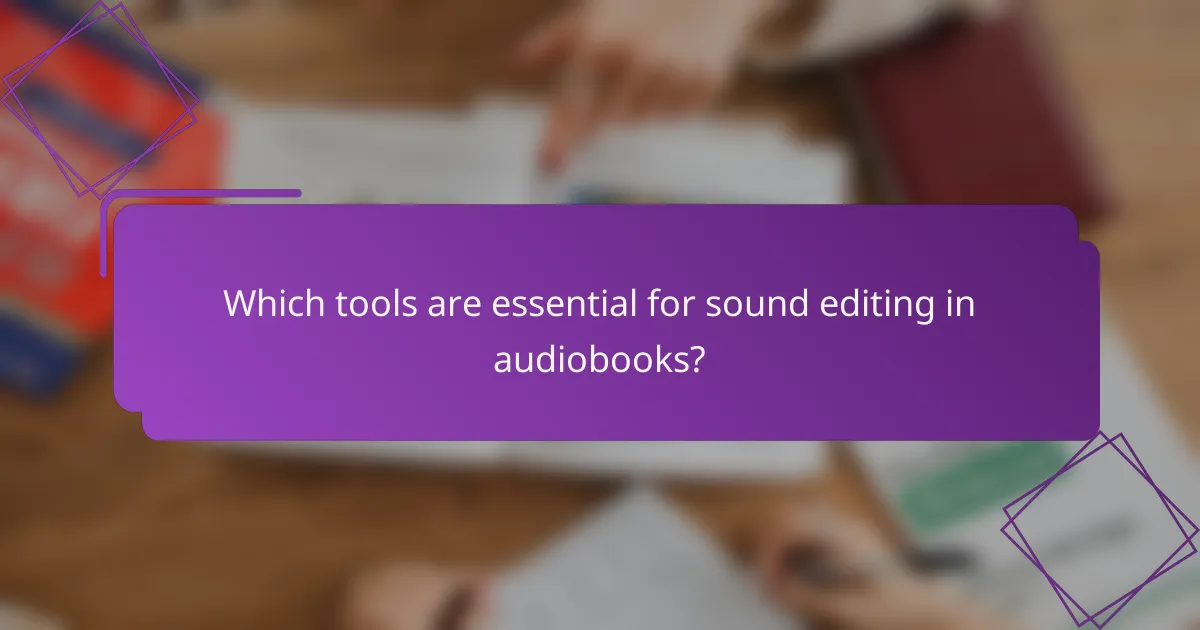
Which tools are essential for sound editing in audiobooks?
Essential tools for sound editing in audiobooks include software that allows for precise audio manipulation, noise reduction, and mixing. Popular choices among professionals are Adobe Audition, Audacity, Pro Tools, and iZotope RX, each offering unique features suited for different editing needs.
Adobe Audition
Adobe Audition is a comprehensive audio editing software favored for its robust features and user-friendly interface. It provides tools for multitrack editing, noise reduction, and sound effects, making it ideal for audiobook production.
Key features include the ability to work with multiple audio tracks simultaneously and advanced spectral editing tools. This allows editors to isolate and correct specific audio issues, enhancing overall sound quality.
Audacity
Audacity is a free, open-source audio editing tool that is widely used for its accessibility and functionality. It supports various audio formats and offers essential editing features like trimming, fading, and noise reduction.
While it may lack some advanced features found in paid software, its simplicity makes it a great choice for beginners. Users should be aware of its limitations in handling larger projects, as it can become less efficient with extensive audio files.
Pro Tools
Pro Tools is considered the industry standard for professional audio editing and is widely used in audiobook production. It offers powerful editing capabilities, extensive plugin support, and high-quality audio processing.
This software is particularly effective for complex projects requiring detailed sound design and mixing. However, its cost and steep learning curve may be a barrier for some users, making it more suitable for established studios or serious audiobooks producers.
iZotope RX
iZotope RX is a specialized audio repair and enhancement tool that excels in cleaning up recordings. It features advanced algorithms for noise reduction, click removal, and spectral repair, which are essential for achieving a polished audiobook sound.
Using iZotope RX can significantly improve audio quality by addressing common issues like background noise and unwanted sounds. It is often used in conjunction with other editing software to refine the final product, ensuring a professional listening experience.

How does sound editing impact audiobook quality?
Sound editing significantly enhances audiobook quality by refining audio clarity, ensuring a pleasant listening experience, and minimizing distractions. Effective sound editing techniques can transform raw recordings into polished productions that engage listeners and convey the intended message clearly.
Enhances listener experience
Sound editing plays a crucial role in enhancing the overall listener experience by creating an immersive audio environment. By adjusting sound levels, removing background noise, and adding effects, editors can make the narration more engaging and enjoyable.
For instance, incorporating subtle sound effects or ambient sounds can transport listeners into the story’s setting, making the experience more vivid. This attention to detail can lead to higher listener retention and satisfaction.
Improves clarity and intelligibility
Clarity and intelligibility are vital for effective communication in audiobooks. Sound editing techniques, such as equalization and compression, help ensure that the narrator’s voice is clear and easy to understand, regardless of the listener’s environment.
Using tools like noise gates can eliminate unwanted sounds, while proper balancing of frequencies can enhance vocal presence. These adjustments contribute to a more professional sound that allows listeners to focus on the content without straining to hear or comprehend.
Reduces listener fatigue
Listener fatigue can occur when audio quality is poor or inconsistent, leading to discomfort during prolonged listening sessions. Sound editing helps mitigate this issue by creating a smooth and balanced audio experience.
Maintaining consistent volume levels and avoiding abrupt changes in sound can prevent listeners from becoming fatigued. Additionally, using appropriate pacing and pauses in narration can enhance comprehension and keep the audience engaged for longer periods.

What are the prerequisites for effective sound editing?
Effective sound editing requires a solid understanding of audio fundamentals, familiarity with editing software, and knowledge of recording techniques. These elements ensure that the final product is polished and professional, meeting industry standards.
Understanding audio fundamentals
Grasping audio fundamentals is crucial for sound editing. This includes knowledge of sound waves, frequency ranges, and dynamic range, which influence how audio is perceived. Understanding these concepts helps in making informed decisions about audio quality and clarity.
Key aspects to consider include the difference between mono and stereo sound, as well as the importance of sample rates and bit depth. For instance, a sample rate of 44.1 kHz and a bit depth of 16 bits are common standards for high-quality audio.
Familiarity with editing software
Being proficient in editing software is essential for effective sound editing. Popular tools like Audacity, Adobe Audition, and Pro Tools offer various features that facilitate audio manipulation. Each software has its strengths, so choosing one that fits your workflow is important.
When using editing software, familiarize yourself with key functions such as cutting, fading, and applying effects. A good practice is to explore tutorials and user guides to maximize your efficiency and avoid common mistakes, such as over-processing audio.
Knowledge of recording techniques
Understanding recording techniques significantly impacts sound editing quality. This includes knowing how to set up microphones, choose appropriate recording environments, and manage levels to avoid distortion. Proper recording lays the foundation for easier editing later on.
For example, using a pop filter can reduce plosive sounds, while selecting a quiet room minimizes background noise. Additionally, maintaining consistent recording levels helps prevent the need for excessive adjustments during the editing process.
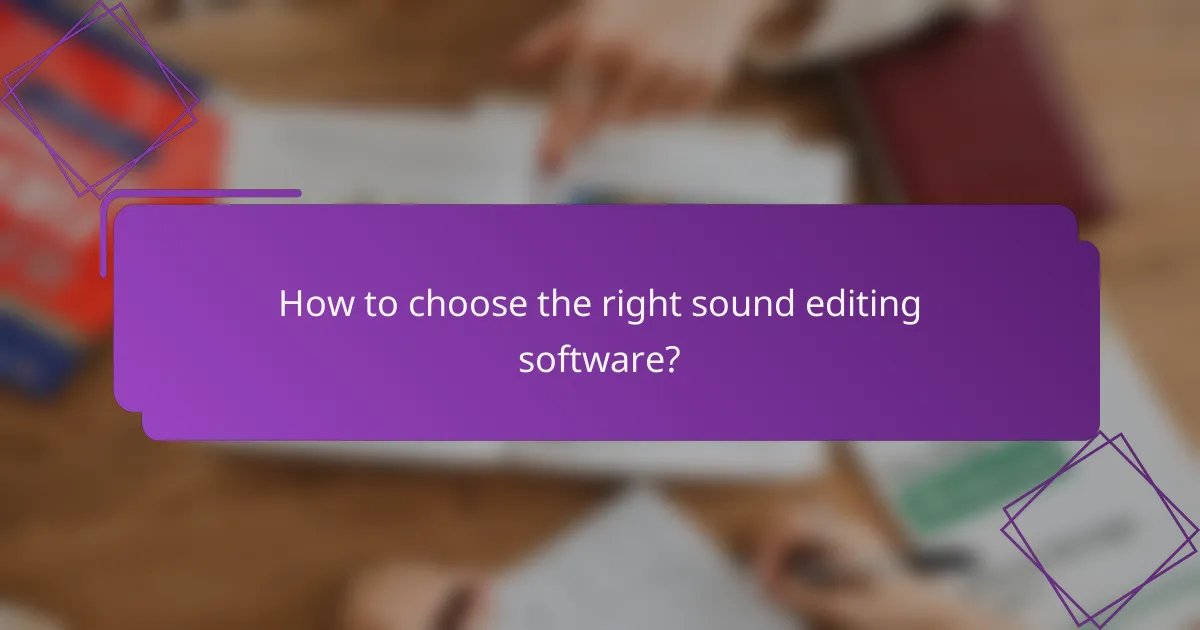
How to choose the right sound editing software?
Choosing the right sound editing software is crucial for effective audiobook production. Look for software that balances user-friendliness, compatibility with your hardware, and the specific features you need for editing audio efficiently.
Evaluate user interface
A user-friendly interface is essential for smooth sound editing. Look for software that offers intuitive navigation, clear labeling, and customizable layouts to enhance your workflow. Software with a steep learning curve can slow down production, so prioritize options that provide tutorials or a supportive community.
Consider trying out demos or free versions to assess how comfortable you feel with the interface. Key features to look for include drag-and-drop functionality, waveform visualization, and easy access to tools like noise reduction and equalization.
Consider compatibility with hardware
Ensure that the sound editing software you choose is compatible with your existing hardware, including your computer’s operating system and audio interfaces. Some software may require higher processing power or specific audio drivers, which can affect performance.
Check the software’s system requirements and compare them with your hardware specifications. If you plan to use external microphones or mixers, confirm that the software supports these devices to avoid any connectivity issues during production.


